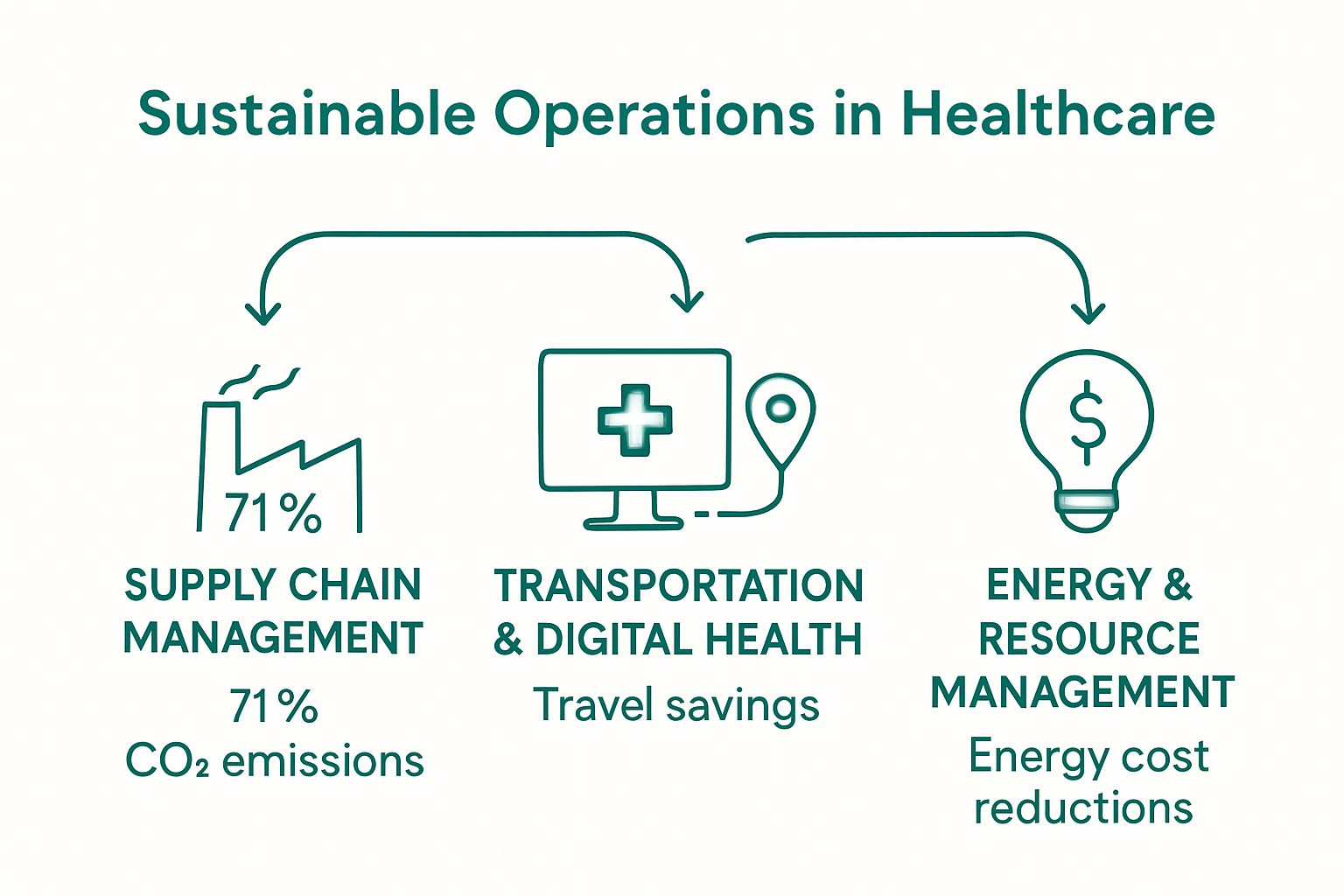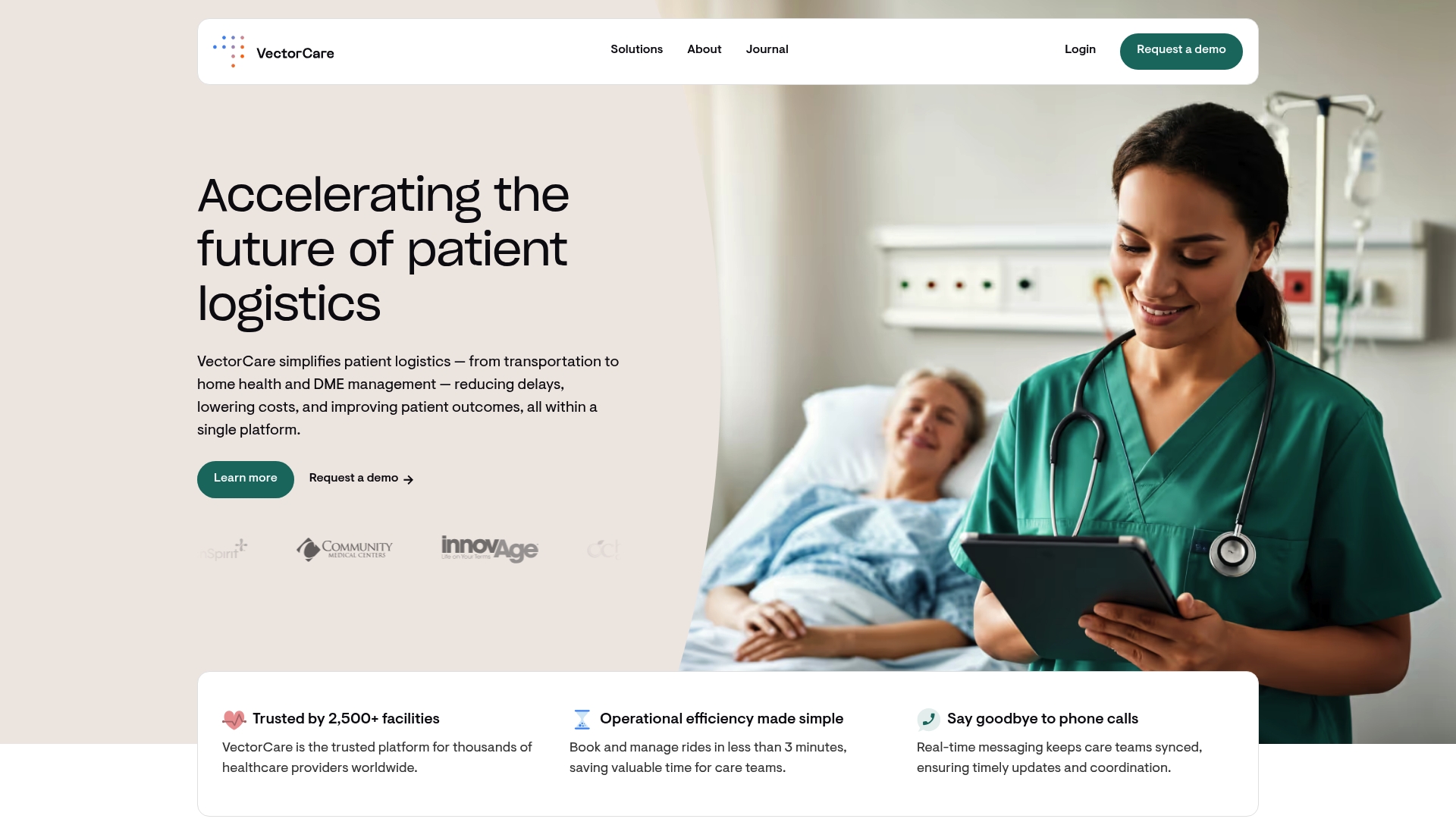Top Sustainable Practices in Healthcare for 2025 Success

Healthcare leaders are under pressure to find new ways to improve results while staying mindful of our planet. It might sound daunting when healthcare facilities account for around 18% of the sector’s total carbon footprint and the U.S. healthcare system makes up 8.5% of national emissions. But here is the surprise. Hospitals are proving that going green is not just about saving the environment. It is unlocking millions in savings and better health outcomes for both patients and communities.
Table of Contents
- How Sustainability Benefits Healthcare Organizations
- Key Strategies For Sustainable Operations
- Implementing Green Technologies And Processes
- Improving Community Health Through Sustainability
Quick Summary
| Takeaway | Explanation |
|---|---|
| Sustainability enhances financial performance. | Implementing sustainable practices reduces operational costs and leads to significant savings over time. |
| Adopt comprehensive supply chain management. | Focus on selecting eco-friendly suppliers and optimizing procurement processes to minimize carbon emissions. |
| Leverage digital health innovations. | Expanding telehealth services can significantly reduce patient transportation needs and associated costs. |
| Invest in energy-efficient technologies. | Using renewable energy and smart building technologies cuts utility expenses and improves overall sustainability efforts. |
| Engage communities for health improvements. | Implementing programs that promote environmental health awareness boosts community resilience and public health outcomes. |
How Sustainability Benefits Healthcare Organizations
Healthcare organizations are increasingly recognizing sustainability as a strategic imperative that extends far beyond environmental responsibility. By implementing sustainable practices, healthcare providers can simultaneously reduce operational costs, improve patient outcomes, and create significant positive impact across multiple dimensions of organizational performance.
Financial Advantages of Sustainable Healthcare Strategies
Sustainability is not just an ethical choice but a compelling financial strategy. Research from the National Academy of Medicine reveals that healthcare facilities account for approximately 18% of the sector’s total carbon footprint, presenting substantial opportunities for cost reduction. Innovative approaches like renewable energy implementation can generate significant financial benefits.
For instance, Boston Medical Center demonstrated the economic potential of sustainability by investing in a $15 million cogeneration plant. This strategic investment was partially funded through state resiliency grants and utility incentives, projected to save $1.5 million annually. Such initiatives showcase how sustainable practices can simultaneously reduce environmental impact and generate substantial financial returns.
Healthcare organizations can achieve cost savings through multiple sustainable interventions:
- Energy Efficiency: Implementing energy-efficient technologies and renewable energy sources can dramatically reduce utility expenses.
- Waste Reduction: Minimizing medical waste through strategic recycling and resource management lowers disposal costs.
- Resource Optimization: Streamlining supply chains and reducing unnecessary medical interventions can significantly decrease operational expenses.
Health and Environmental Impact
Sustainable healthcare practices directly contribute to improved patient outcomes and public health. By focusing on preventative strategies and environmentally conscious approaches, healthcare organizations can address broader health determinants while reducing their ecological footprint.
The Commonwealth Fund’s research highlights how decarbonization strategies can lower disease risks associated with environmental factors. Interventions promoting healthier lifestyles can simultaneously reduce medical intervention needs and greenhouse gas emissions. For example, strategies encouraging healthier diets and reduced tobacco use can decrease cardiovascular disease rates while minimizing the environmental impact of related medical treatments.
Organizational Resilience and Reputation
Sustainability initiatives enhance an organization’s reputation and operational resilience. Healthcare providers demonstrating commitment to environmental stewardship attract socially conscious patients, employees, and investors. By proactively addressing climate-related challenges, organizations can:
- Develop more robust emergency response capabilities
- Attract top talent interested in purpose-driven healthcare
- Differentiate themselves in a competitive healthcare marketplace
Moreover, sustainable practices prepare healthcare organizations for future regulatory requirements and potential climate-related disruptions. Read more about technological strategies that support sustainable healthcare.
By embracing sustainability, healthcare organizations can create a virtuous cycle of financial savings, improved patient care, and positive environmental impact. The future of healthcare lies not just in treating illness but in comprehensively promoting health while minimizing ecological harm.
Key Strategies for Sustainable Operations
Healthcare organizations seeking to implement sustainable operations must adopt comprehensive, strategic approaches that address multiple dimensions of environmental and operational efficiency. These strategies go beyond simple cost-cutting measures and require a holistic transformation of organizational practices.
To help compare the main focus areas and benefits of sustainable operational strategies discussed, see the table below:
| Strategy Area | Main Approaches/Examples | Core Benefits |
|---|---|---|
| Sustainable Supply Chain Management | Eco-friendly vendors, lifecycle assessment, circular economy principles | Reduced emissions, cost savings |
| Transportation & Digital Health | Telehealth expansion, virtual consults, route optimization | Lower travel emissions/costs, efficiency |
| Energy & Resource Management | Smart buildings, renewable energy, performance monitoring | Utility cost reduction, sustainability |
Sustainable Supply Chain Management
Research from Philips reveals that supply chains account for 71% of CO2 emissions in healthcare, making procurement practices a critical focus for sustainability efforts. Healthcare organizations can significantly reduce their environmental footprint by implementing strategic procurement criteria and establishing minimum sustainability standards.
Key approaches to sustainable supply chain management include:
- Vendor Selection: Prioritize suppliers with demonstrated commitment to environmental sustainability
- Lifecycle Assessment: Evaluate medical equipment and supplies based on their total environmental impact
- Circular Economy Principles: Develop strategies for equipment reuse, recycling, and responsible disposal
By reimagining procurement processes, healthcare organizations can drive meaningful environmental change while maintaining high-quality patient care standards.
Transportation and Digital Health Innovations
Healthcare transportation represents another significant opportunity for sustainability. UC Davis Health’s telehealth initiatives demonstrate the potential impact of digital health strategies. Their program prevented over 53 million miles of patient travel, saving an estimated 204 cumulative years of travel time and more than $33 million in travel-related costs.
Effective strategies for sustainable healthcare transportation include:
- Expanded Telehealth Services: Reduce patient and provider travel through comprehensive digital health platforms
- Virtual Consultations: Implement robust remote monitoring and consultation technologies
- Efficient Patient Transport Routing: Optimize non-emergency medical transportation logistics
Energy Efficiency and Resource Management
Energy consumption represents a substantial opportunity for sustainability in healthcare facilities. A community hospital in Wisconsin demonstrated the financial potential of energy efficiency by saving $800,000 annually through strategic facility retrofitting.
Comprehensive energy management strategies include:
- Smart Building Technologies: Implement advanced HVAC controls and lighting systems
- Renewable Energy Integration: Invest in solar, wind, and other clean energy sources
- Energy Performance Monitoring: Develop real-time energy consumption tracking systems

Learn more about technological strategies supporting sustainable healthcare operations.
Sustainable operations are not just an environmental imperative but a strategic approach to healthcare management. By integrating these comprehensive strategies, organizations can reduce their ecological footprint, lower operational costs, and create more resilient, future-focused healthcare systems.
Implementing Green Technologies and Processes
Healthcare organizations are increasingly recognizing the critical role of green technologies and processes in creating environmentally responsible and operationally efficient healthcare systems. By strategically integrating innovative technologies and sustainable practices, healthcare providers can significantly reduce their environmental impact while improving overall organizational performance.
The following table summarizes key green building strategies and their focus areas for sustainable healthcare facility design, as described in the section below:
| EPA Green Building Strategy | Focus Area/Example |
|---|---|
| Energy Efficiency | Integrated design, advanced HVAC |
| Water Conservation | Efficient process water systems |
| Material Selection | Sustainable flooring/building materials |
| Indoor Air Quality | Low-impact material selection |
| Lighting Optimization | Balanced artificial and daylighting |
Strategic Green Building Design
The U.S. Environmental Protection Agency (EPA) has identified five critical green building strategies specifically tailored for healthcare facilities. These comprehensive approaches focus on creating more sustainable and efficient healthcare environments:
- Energy Efficiency: Implementing integrated design and advanced HVAC systems
- Water Conservation: Developing process water efficiency strategies
- Material Selection: Choosing sustainable flooring and building materials
- Indoor Air Quality: Selecting materials that minimize environmental impact
- Lighting Optimization: Balancing artificial and natural lighting systems
These strategies demonstrate how architectural and design choices can dramatically reduce a healthcare facility’s environmental footprint while creating healthier working and healing environments.
Comprehensive Sustainability Processes
Research published in Healthcare (Basel) highlights a holistic approach to green operations in healthcare. Beyond physical infrastructure, sustainable processes encompass multiple organizational dimensions:
- Alternative Energy Sources: Transitioning to renewable energy platforms
- Low Carbon Transportation: Implementing eco-friendly patient and staff mobility solutions
- Local Food Sourcing: Developing sustainable nutritional supply chains
- Waste Reduction: Creating comprehensive waste management and recycling programs
- Water Conservation: Developing advanced water management technologies
By integrating these processes, healthcare organizations can achieve significant environmental, health, and social benefits that extend beyond traditional operational metrics.
Technology-Driven Sustainability Innovations
The EPA’s New England region provides extensive guidance on pollution prevention and best management practices for healthcare facilities. Emerging technologies are playing a crucial role in driving sustainable healthcare innovations:
- Digital Health Platforms: Reducing physical resource consumption through virtual consultations
- AI-Powered Energy Management: Optimizing resource utilization through intelligent systems
- Smart Waste Sorting Technologies: Enhancing recycling and waste management efficiency
- IoT-Enabled Resource Monitoring: Real-time tracking of energy and water consumption
Explore technological strategies that support sustainable healthcare operations.
Implementing green technologies and processes is not merely an environmental responsibility but a strategic approach to modern healthcare management. By embracing these innovative solutions, healthcare organizations can create more resilient, efficient, and environmentally conscious systems that benefit patients, staff, and the broader community.
Improving Community Health Through Sustainability
Sustainability in healthcare extends far beyond organizational boundaries, directly impacting community health and well-being. By adopting comprehensive environmental strategies, healthcare organizations can create meaningful positive changes that address broader public health challenges and support community resilience.
Environmental Determinants of Community Health
The Commonwealth Fund’s 2025 Guide to Communicating Sustainability highlights that the U.S. healthcare sector contributes 8.5% of national carbon emissions, underscoring the significant potential for healthcare systems to influence community health through sustainable practices.
Key environmental factors affecting community health include:
- Air Quality Improvement: Reducing emissions that contribute to respiratory diseases
- Climate Change Mitigation: Addressing health risks associated with environmental shifts
- Resource Conservation: Protecting community ecosystems and natural resources
- Pollution Reduction: Minimizing environmental toxins that impact public health
Healthcare organizations can play a pivotal role in creating healthier living environments by systematically addressing these critical determinants.
Resilient Healthcare Infrastructure
The World Health Organization’s 2024 report emphasizes the importance of developing healthcare facilities that can withstand environmental challenges while providing continuous, quality care.
Strategies for building community health resilience include:
- Climate-Adaptive Facilities: Designing healthcare spaces that can operate during extreme environmental events
- Emergency Preparedness: Creating robust response systems for environmental health crises
- Community Health Education: Developing programs that promote environmental health awareness
- Preventative Health Initiatives: Implementing strategies that address root causes of environmental health risks
Discover tools to improve patient outcomes in community health settings.
Holistic Approach to Sustainable Community Health
The Joint Commission’s Sustainable Healthcare initiative emphasizes the interconnected nature of healthcare sustainability and community well-being. By adopting a comprehensive approach, healthcare organizations can create meaningful improvements in public health:
- Integrated Care Models: Developing holistic approaches that address environmental and health factors
- Community Engagement: Creating participatory programs that empower local populations
- Innovative Health Solutions: Implementing technologies that support sustainable community health
- Equitable Health Access: Ensuring sustainable healthcare reaches all community segments

Improving community health through sustainability requires a multifaceted approach that goes beyond traditional healthcare delivery. By reimagining healthcare as a comprehensive system of environmental and social support, organizations can create lasting positive impacts that extend far beyond individual patient interactions. This approach recognizes that true health is deeply connected to the broader environmental and social contexts in which communities live and thrive.
Frequently Asked Questions
What are the benefits of sustainable practices in healthcare?
Sustainable practices in healthcare can lead to improved financial performance, better patient outcomes, enhanced organizational resilience, and a positive impact on the environment. By reducing operational costs and focusing on preventative health strategies, healthcare organizations can provide better care while minimizing their ecological footprint.
How can healthcare organizations implement sustainable supply chain management?
Healthcare organizations can implement sustainable supply chain management by prioritizing eco-friendly suppliers, conducting lifecycle assessments of products, and applying circular economy principles to reduce waste and emissions throughout the procurement process.
What role does technology play in achieving sustainability in healthcare?
Technology plays a crucial role in achieving sustainability by enabling energy management systems, facilitating telehealth services that reduce transportation needs, and improving waste management with smart sorting technologies. These innovations help streamline operations and reduce environmental impact.
How can sustainability improve community health?
Sustainability can improve community health by addressing environmental determinants such as air quality, climate resilience, and resource conservation. Healthcare organizations can develop initiatives that promote public health, reduce pollution, and educate communities on healthy practices related to their environment.
Transform Sustainable Goals Into Real Healthcare Impact
Hospitals and health systems face mounting pressure to cut costs and shrink their carbon footprint, yet many still struggle with outdated, manual processes that create waste and delay care. This article highlights the urgent need for energy efficiency, smarter supply chain management, and digital health innovations. But how do you truly turn these sustainable strategies into action? The answer lies in connecting your operations with a platform purpose-built to streamline workflows and automate patient logistics from the ground up.

VectorCare helps your organization achieve the sustainable healthcare outcomes discussed here. Move beyond talking about eco-friendly goals and start reducing transportation emissions, vendor waste, and administrative paper trails—all while speeding up patient care and cutting operational costs. Experience how VectorCare’s digital platform supports your journey to financial savings and better patient outcomes with modern scheduling, supply chain transparency, and real-time data insights. Ready to set your health system up for 2025 success? See how VectorCare enables coordinated, scalable, and compliant healthcare logistics for every stakeholder. Take the next step toward real sustainability right now.



